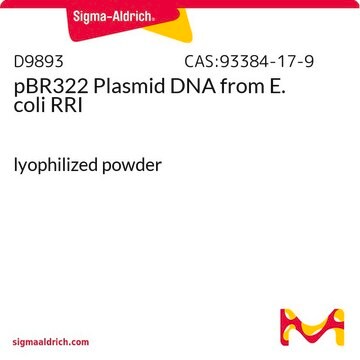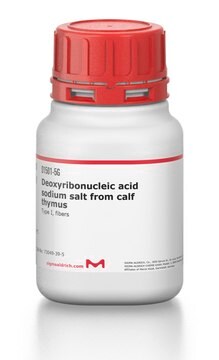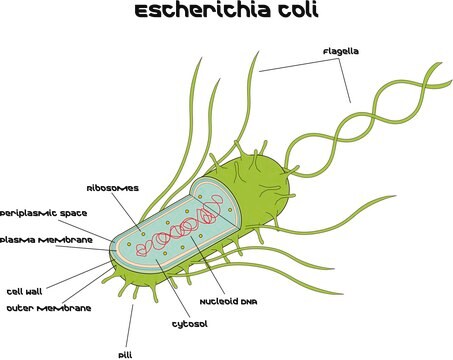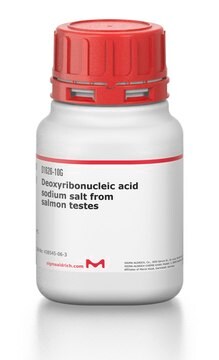D4904
pBR322 Plasmid DNA from E. coli RRI
buffered aqueous solution
Autenticatiper visualizzare i prezzi riservati alla tua organizzazione & contrattuali
About This Item
Numero CAS:
Numero CE:
Numero MDL:
Codice UNSPSC:
12352200
eCl@ss:
32160414
NACRES:
NA.51
Prodotti consigliati
Ricombinante
expressed in E. coli
Livello qualitativo
Grado
for molecular biology
Stato
buffered aqueous solution
PM
2.9 MDa
4363 bp
Origine di replicazione
BR322
Selezione
ampicillin
Condizioni di spedizione
dry ice
Temperatura di conservazione
−20°C
Cerchi prodotti simili? Visita Guida al confronto tra prodotti
Descrizione generale
Plasmid pBR322 was one of the first multipurpose cloning vectors constructed for use in E. coli. This plasmid is derived from the ColE1-type plasmid pMB1 and shares the same type of replication mechanism and controls as ColE1 and relatives. Plasmid pBR322 confers resistance to ampicillin and tetracycline. The plasmid sequence has been published.
The plasmid has unique restriction sites within the gene for ampicillin resistance (Pst I, Pvu I, and Sca I), within the gene for tetracycline resistance (BamH I, BspM I, EcoR V, Nhe I, Nru I, Sal I, Sph I, and Xma III), and elsewhere (Aat II, Ava I, Bal I, Bsm I, BspM II, Cla I, EcoR I, Hind III, Nde I, Pvu II, Ssp I, Sty I, and Tth111 I).
The plasmid has unique restriction sites within the gene for ampicillin resistance (Pst I, Pvu I, and Sca I), within the gene for tetracycline resistance (BamH I, BspM I, EcoR V, Nhe I, Nru I, Sal I, Sph I, and Xma III), and elsewhere (Aat II, Ava I, Bal I, Bsm I, BspM II, Cla I, EcoR I, Hind III, Nde I, Pvu II, Ssp I, Sty I, and Tth111 I).
Specificità
Unique Sites: Within the gene for ampicillin resistance: Pst I, Pvu I, Sca I; Within the gene for tetracycline resistance: BamH I, BspM I, EcoR V, Nhe I, Nru I, Sal I, Sph I, Xma III; other unique sites: Aat II, Ava I, Bal I, Bsm I, BspM II, Cla I, EcoR I, Hind III, Nde I, Pvu II, Ssp I, Sty I, Tth111 I.
Applicazioni
Plasmid pBR322 was one of the first multipurpose cloning vectors constructed for use in Escherichia coli. This plasmid and derivatives have been used for a number of purposes including cloning, selection and expression of recombinant molecules, construction of shuttle vectors and vectors for nucleotide sequencing, studies of elements involved in gene expression, as plasmid DNA standards, and as a model system for studies on prokaryotic plasmid replication.
pBR322 Plasmid DNA from E. coli RRI has been used to study about ferrous ion-induced strand breaks in the plasmid pBR322 are mediated through hydrogen peroxide.
Azioni biochim/fisiol
This plasmid is derived from the ColE1-type plasmid pMB1 and shares the same type of replication mechanism and controls as ColE1 and relatives.
Componenti
DNA is provided in a solution of 10 mM Tris-HCl (pH 8.0) with 1 mM EDTA.
Altre note
Accession number: J01749
Prodotti correlati
N° Catalogo
Descrizione
Determinazione del prezzo
Codice della classe di stoccaggio
11 - Combustible Solids
Classe di pericolosità dell'acqua (WGK)
WGK 3
Punto d’infiammabilità (°F)
Not applicable
Punto d’infiammabilità (°C)
Not applicable
Dispositivi di protezione individuale
Eyeshields, Gloves, type N95 (US)
Scegli una delle versioni più recenti:
Possiedi già questo prodotto?
I documenti relativi ai prodotti acquistati recentemente sono disponibili nell’Archivio dei documenti.
Jörg Flemmig et al.
European biophysics journal : EBJ, 36(4-5), 377-384 (2006-10-19)
Ferrous ion-induced generation of single and multiple strand breaks in the DNA plasmid pBR322 induces the formation of two new plasmid forms with altered electrophoretic mobility. The yield of these plasmid forms, the circular relaxed and the linear forms, depended
Ferrous ion-induced strand breaks in the DNA plasmid pBR322 are not mediated by hydrogen peroxide
Flemmig J and Arnhold J
European Biophysics Journal, 36(4-5), 377-384 (2007)
Charles J Addison et al.
BioTechniques, 37(3), 376-378 (2004-10-09)
Transformation of Escherichia coli plays an important role in recombinant DNA technology. Most current transformation protocols require that the cells be treated to attain a particular physiological state known as "competence," and this makes transformation procedures lengthy and arduous. Here
Il team dei nostri ricercatori vanta grande esperienza in tutte le aree della ricerca quali Life Science, scienza dei materiali, sintesi chimica, cromatografia, discipline analitiche, ecc..
Contatta l'Assistenza Tecnica.








